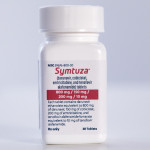Two-year follow-up data from two Phase III clinical trials of Isentress (raltegravir) were reported by Roy Steigbigel, PhD, of SUNY Stony Brook School of Medicine on Long Island, New York, on Monday, February 9, at the 16th Conference on Retroviruses and Opportunistic Infections (CROI) in Montreal. The studies, involving patients with multidrug-resistant HIV and advanced infection, indicate that Merck’s integrase inhibitor offers long-lasting antiretroviral activity for treatment-experienced patients piecing together an effective antiretroviral (ARV) regimen.
Because integrase inhibitors work differently from other HIV drugs on the market, they potentially offer a lot of hope for HIV-positive people, especially those who have developed HIV resistance to older ARVs.
The U.S. Food and Drug Administration granted Isentress accelerated approval in October 2007 and traditional approval on January 29, 2009. It was given the green light by the agency for use in ARV-experienced patients, based on 24- and 48-week data from two Phase III clinical trials, dubbed BENCHMRK-1 and BENCHMRK-2.
The BENCHMRK clinical trials are randomized evaluations of Isentress (400 mg twice daily) compared with placebo, both combined with an optimized background regimen (OBR), in patients with multipledrug-resistant HIV and a history of treatment failure (including the regimens they were taking before enrollment).
BENCHMRK-1, conducted in Europe, Asia, the Pacific and Peru, randomized 232 patients to Isentress plus OBR and 118 patients to placebo plus OBR. BENCHMRK-2, conducted in North and South America, assigned 230 patients to receive Isentress/OBR and 119 patients to receive placebo/OBR.
Ninety-six week data from both studies, in the form of a combined analysis, were reported at the 16th CROI.
The average viral load upon entering the studies was about 50,000 copies in the Isentress groups and 40,000 copies in the placebo groups. CD4 counts, at baseline, averaged 119 cells in the Isentress group and 123 cells in the placebo groups.
After 96 weeks in the BENCHMRK studies, 57 percent of patients receiving Isentress/OBR maintained viral loads below 50 copies—undetectable by today’s standards—compared with 26 percent of those receiving placebo/OBR. This difference was highly statistically significant, meaning it was too great to have occurred by chance.
The researchers also reported treatment outcomes among patients entering both studies with low and high viral loads and varying CD4 cell counts. Among those who began treatment with viral loads above 100,000 copies, 47 percent in the Isentress group and 13 percent in the placebo group had viral loads below 50 after 96 weeks. As for those with viral loads at or below 100,000, the undetectable viral load rates after 96 weeks were 70 percent and 36 percent respectively.
About 54, 69 and 65 percent of patients with prestudy CD4 counts below 50 cells, between 50 and 200 cells and above 200 cells, respectively, kept their viral loads below 50 copies for 96 weeks of Isentress treatment. In the placebo group, undetectable viral load rates were 11, 31 and 35 percent, respectively.
Differences between the two groups, with respect to CD4 gains, were also statistically significant. Isentress/OBR recipients had an average 123 CD4-cell gain, compared with a CD4 gain of 49 cells in the placebo group.
Additionally, there was a trend toward lower rates of new or recurrent AIDS-related conditions or death in the Isentress/OBR groups compared with the placebo groups. However, these data were not statistically significant, though significant differences may emerge with longer follow-up.
Not surprisingly, those using Isentress with two new ARVs—notably Prezista (darunavir) and Fuzeon (enfuvirtide)—as a component of their OBR were the most likely to keep their viral loads undetectable for 96 weeks.
About 25 patients had documented virologic failure—a rebound in viral load, for example—between weeks 48 and 96, including eight patients in the placebo/OBR group and 17 in the Isentress/OBR group. Eleven of the patients with virologic failure in the Isentress/OBR group were tested for drug resistance—seven had HIV with Isentress mutations, four did not.
A few patients discontinued treatment because of side effects. The most commonly reported side effects—occurring in at least 2 percent of patients—among patients receiving Isentress in either study were diarrhea, gas nausea, vomiting, fatigue, injection site pain or reaction (due to Fuzeon), joint pain, dizziness, headache and itching.






3 Comments
3 Comments